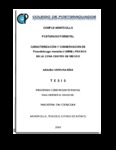Conservación y caracterización de Pseudotsuga menziesii (Mirb.) Franco en la zona centro de México
Abstract
Se ubicaron 29 poblaciones naturales de Pseudotsuga menziesii en Hidalgo, Tlaxcala y Puebla, con un estimado de 9,029 árboles adultos, en 682 ha que se ubican desde 2,450 a 3,400 m s.n.m. Las localidades son de clima templado, con temperatura media anual de 10.1 a 14.0 °C y precipitación de 611 a 1,109 mm anuales. Pseudotsuga convive con Abies religiosa y varias especies de Pinus y Quercus, en exposiciones N, NO y NE. Los suelos son de pH ligeramente ácidos, ricos en materia orgánica y clase textural franco-arenosa o franca. El tamaño poblacional varía de 4 a 1,450 árboles maduros; 11 de éstas menos de 100 individuos adultos, con poca repoblación natural en todas ellas. Existe gran fragmentación en su distribución natural. Con base en un análisis de agrupamiento se detecta similitud entre las poblaciones de Hidalgo (Zona I) y entre las poblaciones de Tlaxcala y Puebla (Zona II); cada zona tiene seis grupos de poblaciones. Para estimar el grado de riesgo de desaparición de la especie, se recopiló información en campo y de encuestas a propietarios. Se propusieron tres criterios que inciden en el riesgo: antropogénico (el de mayor peso), genético y ecológico, con seis, cuatro y cuatro sub-criterios, respectivamente. Se usó el Proceso de Análisis Jerarquizado (PAJ) para ordenar y ponderar la importancia de los criterios y subcriterios. Existen niveles de muy bajo a muy alto riesgo. Cuatro poblaciones presentan riesgo muy bajo, riesgo bajo (ocho) y riesgo medio (seis), con distancia promedio a vías de comunicación y a poblados de 3.0 km, y los poseedores se dedican en su mayoría al turismo. Las poblaciones que presentan un riesgo de alto a muy alto, seis y cinco (Vicente Guerrero, Morán, Minatitlán, La Garita y Tonalapa), respectivamente, se encuentran fuertemente influenciadas por factores antropogénicos (distancia promedio a vías de comunicación de 1.4 Km y a poblados de 2.2 km, la actividad económica principal es la agricultura), ecológicos (existen especies exóticas, repoblación natural nula o escasa) y genéticos (número promedio de árboles en edad reproductiva menor de 40, con aislamiento geográfico y la edad de los árboles es madura a sobremadura). Se recomienda realizar actividades de conservación in situ, priorizando en las poblaciones que presentan mayor riesgo, además de considerar la recolección de germoplasma y medidas de migración asistida con repoblación artificial e intercambiar material genético dentro de grupos y ocasionalmente entre estos para restablecer el flujo génico y propiciar mayor variabilidad genética._______Pseudotsuga menziesii (Mirb.) Franco has 29 natural populations located in the states of Hidalgo, Tlaxcala and Puebla, with a total estimate of 9,029 Douglas-fir adult trees growing in an area of 682 hectares. The populations were found at altitudes varying from 2,450 to 3,400 m, in temperate climate, with mean annual temperature ranging from 10.1 to 14.0 °C and average annual rainfall from 611 to 1,109 mm. Pseudotsuga grows in mixed stands with Abies religiosa and several species of Pinus and Quercus, in N, NW and NE aspects. Soils are slightly acidic in pH, rich in organic matter and loamy-sandy or loamy texture. Population size varies from 4 to 1,450 matures trees; 11 populations have less than 100 adult trees. There is little natural regeneration in all of them. There is great fragmentation within their natural range. Based on a cluster analysis similarities between populations from Hidalgo (Zone I) and between locations of Tlaxcala and Puebla (Zone II) were detected; each zone has six groups of populations. In order to estimate the species extinction risk, field information was collected and owners were interview. Three criteria that directly define the risk level were proposed: anthropogenic (the most important), genetic and ecological; considering six, four, and four subcriteria for each criterion respectively. The analytical hierarchy process (AHP) was used to form a hierarchy of the problem and to weight the importance the criteria and subcriteria through pair wised comparison matrices. Risk levels for the Pseudotsuga populations were from very low to very high risk. The populations with a very low risk (four), low risk (eight), and medium risk (six) are those that receive only minor influence from genetic, ecological, and mainly from anthropogenic factors (average distance to roads and urban centers equal to 3 km, the holders devote themselves to the agriculture). The populations with high or very high risk, six and five, respectively, are strongly influenced by anthropogenic (average distance to roads1.4 km and urban centers equal to 2.2 km), ecological (presence of exotic species, null or scarce natural regeneration), and genetic (average number of reproductive-age trees less than 39, average distance among populations equal to 16 km, in other words, geographic isolation, and trees of age from mature to over-mature). It is recommended to realize in situ conservation activities prioritizing its implementation on the populations with the highest identified risk; it is also recommended to collect germoplasm from those populations and to artificially regenerate them and to exchange genetic material within groups, and occasionally between groups of populations, to restore the gene flow between them and to increase genetic diversity.
Collections
- Tesis MC, MT, MP y DC [289]


